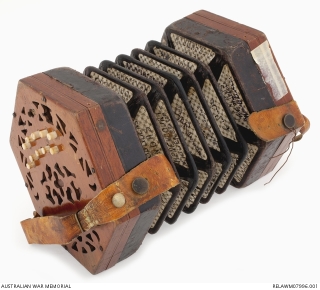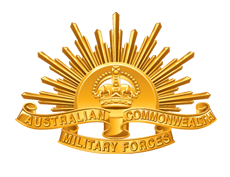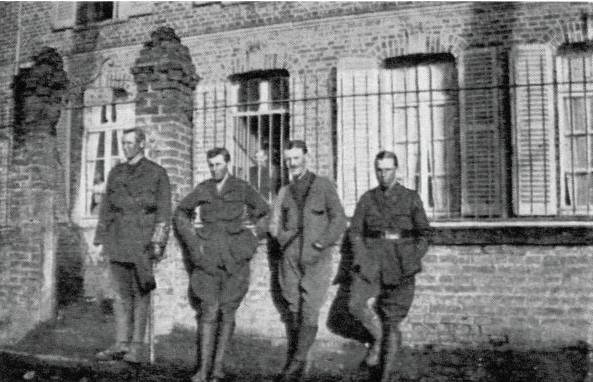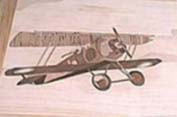Home > History > Regiments 14 - 18
Troops in the area
The village was behind the front lines. The troops based in the area were billeted for a few hours, a few days, or a little longer. They received medical attention, and some mentioned dentist and surgeon appointments.
During these quieter times, the soldiers had to continue training, cleaning rifles, and fixing equipment. The streets had to be regularly backfilled due to the passage of many soldiers, horses, and cars, just as the local airfield was constantly maintained.
Vignacourt was a crossing point for the troops, just like in the neighboring villages. Research and exchanges with other history enthusiasts allowed me to complete the list below.
- Canada
- France
Australia:
John Monash, Major General. The Sir John Monash Centre is located in Fouilloy.
The stretcher-bearers had to carry the wounded under artillery fire on a few occasions because the thick mud of the trenches made it impracticable.
Field ambulances:
- 1st Field Ambulance, Sergeant H. J. Chudleigh, who left us a precious testimony.
He was an accountant for the New South Wales Government Railways and also enjoyed playing music. He played a few times during marches and in churches.
He owned a concertina, an octagonal-shaped accordion invented in England. He had written on the bellows of this instrument the names of places crossed during the war 14-18, such as Abbeville, Allonville, Beauval, Flesselles, Candas, Domart, Doullens, Hérissart, Naours, Château d’Olincourt, Rubempré, Saint-Ouen, Talmas, Vignacourt, and also Hazebrouck, Le Doulieu, Srazeele, Steenbecque, and Bailleul.
All the details are available on the Australian War Memorial website, and to listen to the music, the video is on the link hereafter: #Concertina.
Credit photo AWM - ref RELAWM07996.001
- 4th Field Ambulance - Fressennevile 6th Dec 1917, Vignacourt 1917
- 5th Field Ambulance, Flesselles Castle, 9th October to 1st November 1918, and Vignacourt.
- 8th Field Ambulance, Vignacourt From December 1916 to January 1917, on January 2, 1917, a few men went to the caves near Naours.
- 12th Field Ambulance: Outtersteene, July 1916; Steenwerck, June 1917; Frémont, from September 1st to September 7th, 1918 (4 mi from Vignacourt).
- 13th Field Ambulance, Saveuse From September 25th to November 9th, 1918
The Flying Corps:
- 3rd Squadron, RAAF: Bailleul 1918; Poulainville, 7th April to 30th April 1918; Flesselles, 1st May to 31st May 1918; Villers-Bocage, 1st August to 4th September 1918.
Artillery regiments:
- Field artillery battery,
- Royal Regiment of Artillery,
- Trench mortar battery.21st Field Artillery Brigade, 24th Battery, 1st Division, to Havernas Franvillers from December 23, 1916, to January 12, 1917, and before August 16, 1916, in the township. "The officers speak our language quite well". M. Liyod Lyne, wounded in the thigh in October 1916, was treated in Rouen. He was joined by Lt. Ford of Sydney. January 1917.
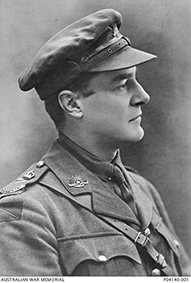
Harold William Riggall, photo credit: AWM P04140.001
- Recovering in Amiens in January 1917 (bronchitis)
Infantry battalions:
2nd Bn: Quartered in Flesselles for 14 days from November 17th, 1916. They took the train from Vignacourt to Ribemont on December 1.
3rd Bn: The ground was completely covered in a layer of snow. Amiens to Flesselles by bus. Winter 1917.
4th Bn: Billeted in Outtersteene From July 9th to July 11th, we marched toward Bailleul to get the train for Candas and marched to billeted in St. Ouen. July 12: march toward Vignacourt to be quartered there. July 13: March towards Allonville, the following place of the cantonment. 1916.
5th Bn, Bapaume, March 1917; Billeted in Ailly-le-Haut-Clocher, November 1, 1918; On November 4, 1918, the Divisional Parade at the church in Long was officiated by the Bishop of Amiens. Photo of officiers by LT in November 1916 (H13947).
6th Bn, Ailly-le-Haut-Clocher, 1st to 6th October 1918 ("Ca ne fait rien" - Never mind, no problem, probably an expression probably often heard).
7th January–11th July 1916, Passed through Candas, Fieffes, and Canaples. Billeted in Berteaucourt (this is Berteaucourt-les-Dames...), it passed through Vignacourt.
Training, cleaning... Ailly-le-Haut-Clocher, month of October 1918.12th Bn: Leave Halloy-Les-Pernois on July 12, 1916, at 10 a.m. and march to Naours, then to Rubempré on July 16, 1916.
13th Bn: Billeted in Poulainville (training, football match at Allonville) from September 1st to September 9th, 1918.
At the front for several days from September 17, and cantonment in Picquigny from October 1 to 13 November 1918.
Training, football or rugby matches, brigade parade in Crouy, then a trip to Saleux on November 14 to take the train to Epehy.14th Bn: Two companies of the 14th Bn. were quartered in barns at Allonville. The buildings were bombed by the Germans; several soldiers were wounded, and others died. Allonville on May 31, 1918.
15th Bn: Battalion billeted in Rainneville after a march from Ribemont on January 2, 1917, at Vignacourt from January 3 until 13: Units 57th to La Chaussée and 58th to St-Vaast.
16th Bn - Battalion billeted in Picquigny October early Nov 1918.
17th Bn 5th Brigade, November 8, 1918, in Vignacourt, peace was imminent. One of the streets in this village is called "General Martin..."
18th Bn: Lieutenant Joseph Maxwell, VC, was incorporated into the 18th Bn. The battalion had been played near the Vignacourt Church on November 11th, 1918.
19th Bn: Billeted in Vignacourt on 8th, 9th, and 10th October 1918.
20th Bn: Private Alfred Binskin, with a comrade, scaled the church tower to raise Australian and French flags on November 11, 1918.
21st Bn: After Mount St-Quentin, the Bn retires towards Cappy while marching on September 5, 1918, until the end of the month for the rest of the troops.
22nd Bn: Arrived by train to Flesselles; the men were re-equipped in Flesselles from December 1st, 1916, to Christmas.
23rd Bn - 6th brigade - Battalion arrived by train to Vignacourt on 1st Dec. from there, they marched to Flesselles - 2 weeks training - Flesselles - Dec 1916
24th Bn - Hindenburg line then La Chaussée (Near Picquigny) 8th Oct 1918 to 25 Nov 1918. On November 11th 1918, in la Chaussée-Tirancourt.
On November 23rd, 1918, they marched toward Vignacourt.25th Bn - Trench system near Blangy Tronville from 20th July to 31st July 1918, tank training close to Vaux-en-Amienois on 31st July 1918.
29th Bn - Vignacourt - Nov 1916. Corporal James Douglas McDowall and Sergeant Robert Edward Charles were both of the 29th Battalion. (Christmas 1917 was held in Desvres, on December 26it had snowed all day).
30th Bn - Rambures the 1st Nov for a demonstration for a Gaz officer. From the 1st to the 13th of June 1918 in the Glisy area (Amiens South). Several soldiers lie in the cemetery as Captain Arenal Pickering HEXT from Brisbane.
31st Bn - Desvres January 1918 - May 1918 Sector of Corbie, procession to the Church of Franvillers on July 7, Querrieu on August 1, 1918, then after Villers-Bretonneux.
32nd Bn - Desvres Dec 1917, Ramburelles 1st November 1918.
43rd Bn - Cardonnette July 1918 Vaire-sous-Corbie August 1918 Clery-Sur-Somme September 1918, Ramburelles December 1918.
44th Bn - Allonville wood 1918 (Lieut. J. Otto, who did sketches during the war).
51st Bn - Vignacourt from December 18, 1916, to January 2, 1917, and procession to the church on December, 24, 25, and 31, 1916. (3 of them from Dongara in the same platoon, Sergeant A. Criddle, I. Sloper, and Mc)
52nd Bn - Training and usual works of the rear lines, Christmas, and New year took place in Vignacourt - December 1916.
53rd Bn - At the front and arrived on 31st July 1918 to Vaux-en-Amienois for cantonment until August 4, then marched towards Querrieu.
54th BN - Saint-Vast 1st to 4th August 1918, Cardonette 5th August 1918, Daours 6th to 8th August 1918
55th Bn - Sailly-le-Sec on July 1918, after Vaux-sur-Somme on 28th July 1918, Fremont 31 July to 3rd August (HQ), afterward, near Peronne on 1st Sept 1918.
56th Bn - Poullainville 1st August, Daours 7th August, Peronne 1st Sept 1918..
2nd Bn Auckland (NZEF), Picquigny 1916, Breilly, Corbie, Allery, Cardonette.
1st Bn Otago regiment (NZEF), Longpre, Airaisnes October 1916
2nd Bn Otago regiment (NZEF), Longpre October 1916
.
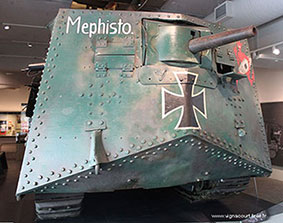
Germain tank retrieved by 26th Bn AIF in Villers-Bretonneux area - Queensland museum.
Machine Gun Companies:
- 2nd Australian Machine Gun Coy, in St-Léger, from 8th to 31st October 1918.
- 22nd Australian Machine Gun Company in the canton - Strazeele April 1918, Allonville on 6th April 1918, Querrieu, Franvilliers then Mericourt in May 1918. And St-Léger on November 1918, (Hangest-sur-Somme on 24th Nov. 1918).
- 7th, 4th battery, 1st Div - Flers, and Vignacourt, from 1st to 18th Dec. 1916.
- 13th - Sailly-le-Sec on 29th March 1918, after Vignacourt.
Transport companies:
- 1st Div Mechanical Transport Company - 6th August 1918 Ailly-Sur-Somme, Longpre-Les-Corps-Saints 30th Sept 1918
- 2nd Mechanical transport company - They passed through other villages near Vignacourt: Flesselles, Ally-Sur-Noye; Péronne, Bohain, Roisel, Poulainville, Tincourt (3rd AMT); but several divisions.... - 1918.
The Rising Sun Badge
The rising sun of the ANZAC Australian and New Zealand Army Corps. The template of the badge used during the First World War below had been made in other versions for special ceremonies, as had the modification of the roller inscription.
Canada:
The Canadian Corps was commanded by Lieutenant-General Sir Arthur Currie.
Ambulance Corps:
Canadian Army Medical Corps - CAMC - Vignacourt then Crouy - summer 1918.
Artillery divisions:
Canadian Railway Troop - CRT (12th) - Vignacourt, Etricourt 1918.
Cavalry divisions:
The Royal Canadian Horse Artillery (France 1915, Havernas 1916?)
The Royal Regiment of Canadian Artillery School (4th battery) - Place, date TBC
Infantry battalions:
- 7th: billeted to Berteaucourt-les-Dames From 13th to 15th Sept 1916.
- 42nd: billeted to Halloy-les-Pernois one night in September 1916; billeted to Herissart the night of September 10, 1916; afterward, march via Talmas, Canaples, Halloy-les-Pernois, and Berteaucourt-les-Dames, where soldiers have been billeted for three days.
- 2nd Company of Princess Patricia’s Canadian Light Infantry was photographed in Flixecourt in November 1915 by the local photographer, Mr. Ernest Daussy. A family of photographers based near the church in this village, located 10 km from Vignacourt. This photo studio was opened about 10 years before the start of the 14-18 war by Ernest Daussy, and the son named Lucien took over.
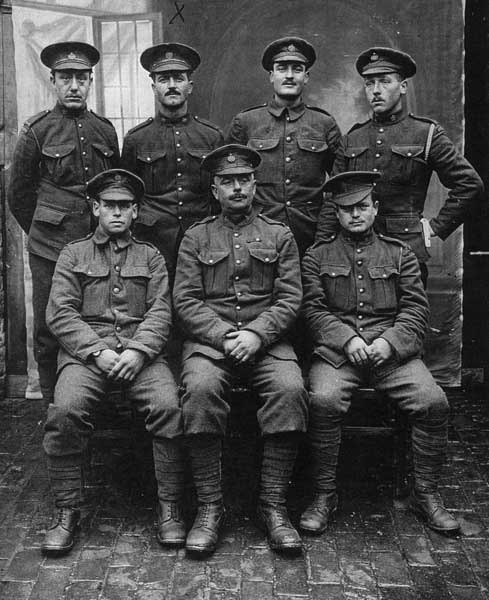
Photo courtesy of Dr. Goldsborough. © Manitoba Historical Society, www.mhs.mb.ca
From left to right and from top to bottom:
Charles Little, William Gavin Johnston, Robert Western, and Sydney Hawkbridge
Harold E. Agar, William B. Crumb, and Fred A. Pritchett
After intense fighting on the front lines, these seven survivors of the No. 2 company were granted a few days of respite. They spent a good part of November 1915 in Flixecourt. Far from the mud and the horrors of trenches, they could have baths, have three hot meals a day, and finally sleep in clean sheets. They spotted the photo studio during a walk in the village near Place Vogel. They all gathered in front of the painted background in this photo. Only two soldiers survived the war.
William Gavin Johnston of Morden, Manitoba, had carefully noted the names of his comrades on the back of the photo. He rose through the ranks, from soldier to captain. He was treated at the end of January 1915 at the 6th medical hospital in Rouen.
His sister, Annie Eliza Johnston (Argue), was a nurse in Gallipoli and Flanders. There is a photo of Annie accompanied by another nurse under the Maltese sun in February 1916 and a photo taken with Robert Fletcher Argue in London in 1919. Letters exchanged during the war were rediscovered 80 years later on a family farm in Oakville, Manitoba.
The men of the company N° 2 PPCLI entered the trenches of Flanders, filled with mud, for the first time on Christmas Eve, 1914. They spent a week digging a secondary line of trenches in front of Hazebrouk, in the north of France.
Princess Patricia’s Canadian Light Infantry, founded during the First World War, was one of the main infantry regiments of the Canadian Armed Forces. It bears the name of Princess Patricia of Connaught, the daughter of the Governor-General at the time. She sewed by hand the standard-bearer, made of silk with embroidery in gold thread, the Ric-a-Dam-Doo.
- : - : - : - : - :- : - : - : - : - :-
- 43rd Cameron Highlanders of Canada came to our township after Ypres at the beginning of September 1916
and before the Battle of the Somme, with the officers commanding: Lt. Col. R. McD. Thomson and Lt. Col. W. Grassie.
These men were from Winnipeg, in Western Canada. This Bn landed in France on February 22, 1916.
Robert MacDonald Thomson was Lieutenant Colonel for the 79th Cameron Highlanders of Canada from 1910 to 1913, and Lieutenant Colonel for the 43rd Bn Canadian Expeditionary Force during the First World war.
He died a month later, on October 8, 1916, in the Ancre Heights (Albert city Sector) during the Somme Offensive. He was killed by a second shell as he was being carried into the horse-drawn ambulance.
William Grassie was born in Scotland, in the County of Dumfries. He came to Canada in 1894.
After a few years on a ranch, he worked for a real estate company and an investment firm.
He joined the CEF Canadian Expeditionary Force in December 1914.
He was awarded the Distinguished Service Order, a military decoration of the United Kingdom. He survived the war and passed away in 1935.
They were present on September 10, 1916, in Saint-leger. 1200 Canadians were quartered there. They played music as they passed through the streets of this village, with brass, fifes, and bagpipes.
That evening, William Grassie and Robert MacDonald Thomson chatted with the guest house owners. They talked about Canada, religion, and history, "Two dates come to mind in 1608 in 1749" ... (See the section: 11th Bn Royal Irish Rifle in the United Kingdom Part for the house.)
Their presence in our canton was confirmed with the cross-checking of several data, and a special thank you for sharing information from:
- Mr. Hugh O'donnell - www.cameronhighlanderscanada.com,
- Mr. Goldsborough - Manitoba Historical Society - www.mhs.mb.ca,
- Mr. Stuart McLean - https://thequeensowncameronhighlandersofcanada.net
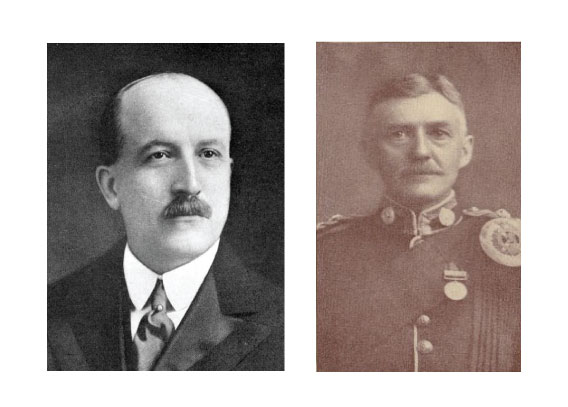
Mr. William Grassie photo, courtesy of Mr. Goldsborough, Manitoba Historical Society,
On the right, Robert MacDonald Thomson, courtesy of Mr. Hugh O'donnell.
- : - : - : - : - :- : - : - : - : - :-
- Royal 22nd Regiment a few days in October 1916 in Saint-Léger-les-Domart.
(5 mi - 7 km from Vignacourt).
M. Mercier as a teacher. He came back to Saint-Léger during permissions. His wife continued to lead the guest house during the war helped by employees. Occasionally, the Army's cook took place in the kitchen to prepare the meal for the British officers.
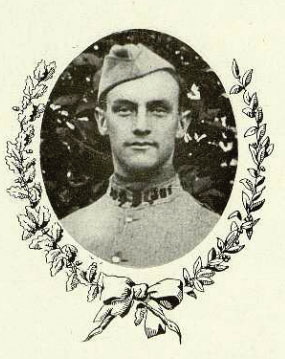
Gaston Mercier, credit photo Archives départementales de la Somme, FRAD080_4°1707.
Guesthouse photo in the section: "11th Bn Royal Irish Rifle in the U.K Part"
"We have at home Captain Vanier, Lieutenants Chassé and Jolicoeur. We were informed the battalion lost 9 out of 22 officers and many non-commissioned officers. The battalion motto on the badge is: I Remember.
The words told by M. Georges P. Vanier on October 10, 1916: "Thousands and thousands of families will come, he says after the war, to see good France again! It will be a place of pilgrimage: What memories! The motto, he adds, is not complete, but it clearly states: I remember France! (He had noted the address of his hosts to come back after the war).
Mr. Georges-Philéas Vanier became the 19th Governor-General of Canada. He had studied law before going to war. He was injured during the First World War. He was a representative of the Free French Forces led by Charles de Gaulle during the Second World War. He visited the liberated Buchenwald camp in 1945 and was appointed Canadian Ambassador to France in Paris after the liberation until 1953.
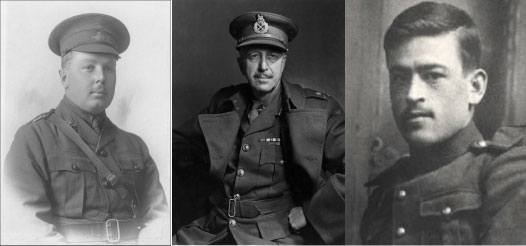
Captaine Henri Chassé - Captaine George P. Vanier - Lieutnant Jolicoeur
Photos courtesy of Cpl Erick Jacques, CD - Credit Archives R22eR.
This beaver sewn on the uniform of these soldiers intrigued many local people during the war. But what is the origin of this battalion, with this animal so strange for our region?
The badge of the 22nd Bn contains the words I remember, which is the motto of Quebec in tribute to this founding nation.
This regiment approached the shores of the St. Lawrence by settling in the citadel of Quebec in 1920. The year 2020 marks the 100th anniversary of the regiment's arrival within these walls. This fortress is open to visitors but is an active military base.
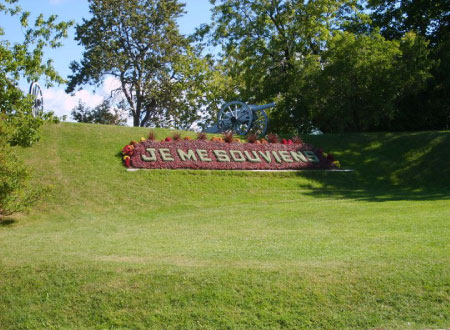
"Je me souviens" "I remember" - Citadel of Quebec - IG photo.
The badge of this regiment is surmounted by a crown in memory of the coat of arms granted by Queen Victoria to the province.
Inside this circle we find:
- The two fleur-de-lis for French origin,
- The lion for the link with Great Britain,
- The three maple leaves are the symbol of Canada,
This set is decorated with a beaver, for the memory of this nation of explorers.
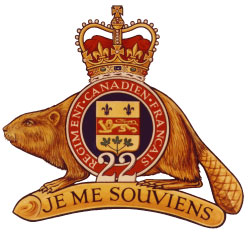
Badge photo, courtesy of Cpl Erick Jacques, CD - Credit Archives R22eR.
France:
Marechal Foch, commander of the allied armies after the Doullens conference.
French soldiers also evoked this mud in the trenches making some sections impractical. The food distribution was difficult, the porters slipped with the pots full of food, and the bread sometimes arrived in a poor condition. The mud weighed down the equipment, some did not hesitate to cut the sides of their outfit to be more comfortable during the marches.
Artillery regiments:
34th artillery regiment - Cantonment for one month from June 17, 1915, in the villages of Flesselles, Saint-Vast-en-Chaussée, Vaux-en-Amienois, and Argoeuvres.
219 RAC - Field artillery regiment - by Ailly Sur Somme, Saint-Vaast, Vignacourt, Canaples, billeting to Hem, Longuevilette - Avril 1918
116 RAL - Heavy artillery - Via Fourdrinoy, Vignacourt for East of Doullens, Ransart, From 12th Avril 1918 for 8 days.
120 RAL - 7th Battery on 14th April 1918 at Vignacourt afterward a few days after Doullens.
320 RAL - Heavy artillery - Fourdrinoy, Picquigny, billeting to Vignacourt Avril 1918
A. L. V. F. (Artillerie lourde voie ferrée): Heavy artillery on railroad. Vignacourt.
Engineer regiments:
- 2nd, Cie 17/52 - Picquigny, La Chaussée, Vignacourt April 1918
- 5th - Labour on the railroad with the Chinese. (Places and date to confirm)
- 7th, Cie 15/1, Domart-sur-la-Luce 1918
Infantry regiments:
- 41st infantry regiment - One bn billeted in Domart-sur-La-Luce - April 1918 (Battle of Hangard-en-Santerre).
- 69th Infantry - Arrival at Naours on May 31, 1918, at 4 am. The same day, a departure of Flesselles at 8 pm, for a marched with the equipment on the back, arrival at 11 pm in Saint-Vaast-en-chaussée and billeting until June 3. Departure at 1am, marched via St-Sauveur, Ailly-sur-Somme, Saveuse and embarkation by train to Saleux at 7am, objective Mery in Oise sector.
- 126th Infantry - reorganization & training, Naours 17th June to 19th July 1915.
- 329th Infantry - Organized the first trenches and repulsed violent attacks -
2086 casualties - Bray-sur-Somme October 1914 to April 1915.- 3rd colonial infantry - 1st Bn - Terrasmenil, Vignacourt, Plivot - July 1915
- 4th colonial infantry - Vignacourt - 1915
- 8th colonial infantry - Instructions - Vignacourt - 9 to 15 July 1915
- 21st Territorial Infantry - rest and training in Naours, From 6 to 21 Jan 1915.
- 130th Territorial Infantry - training - Allonville, 18 June to 5 July 1915.
- 2nd B.T.C.A. Territorial of Chasseurs Alpins, billeting on 30 May 1918 in Havernas, 31th May in Argoeuvres, St-Sauveur, until 3rd June Prouzel.
- 4th B.T.C.A. Territorial of Chasseurs Alpins, from April 29 April to May 6, 1918, airfield maintenance in Vignacourt with Captain MOTTIN. The "Chasseurs Alpins" (Alpine Hunters, mountain infantry).
Cavalry divisions:
1st Cavalry Corps - Amiens region - July 1916.
2nd Cavalry Corps - Amiens region - July 1916.1st Hussards regiment - The mission is to clarify and cover the infantry columns - Ailly-sur-Somme, Vignacourt, Canaples - April 1918 then 17 to 22 December 1918.
2nd Hussards regiment - Grattepanche, Ailly-sur-Noye on March 31, 1918.
12th Hussards regiment, Chiefs of Staff and 4 squadrons, billeted in Amiens, Longueau - Sept, Oct, 1919.
Cuirassiers régiments:
- 2nd - Domart-en-Ponthieu and Candas - 1915 - General Chabaud.

General Chabaud - Photo Crédit Mr. Jérôme Discours - www.military-photos.com
- 4th - "The villagers remembered seeing near the railway station the platoons succeed one another in front of the photographer to preserve, with the last image of their horses, the memory ..." at Gournay-en-Bray in August 1916, "boarding" the August 20th, for Conty. The 1st cavalry division was incorporated into the 4th, with Colonel de Galembert.
- 6th - Berteaucourt-les-Dames - April, May 1915 - Lieutenant Crolard.
- 8th, 9th DC (cavalry division) - Toward Amiens, on 10th May 1915 - Vignacourt, End June, July 1915 (Machine guns section "mitrailleuses", formed from the 16th Feb to 9 May 1915, Roye area) - According to the Colonel Léandri, commander of the 8th Cuirassier Regiment: "8th considered to be an elite regiment" March 1919.
- 12th - Domart-en-Ponthieu, Berteaucourt-les-Dames April to 5 May 1915 - Estrée-Wamin - and Auxi-le-château from 22 May to 16 June 1915.
Dragons regiments:
- 5th Dragons regiment - Havernas - 29 May to 7th June and Long-le-catelet until 14 June and a second time from 22 June to 12 July 1915.
- 6th Dragons regiment - Canaples - June 1915.
- 23rd Dragons regiment - Vignacourt & Halloy-les-Pernois - 11 au 28th May 1915. Montrelet and Fieffes - From 28th May to 15 June 1915, More than 600 men and more than 700 horses on 31 May 1915. Riders: Petijean, Collier, Bertin, Fossat. Lieutenant 2nd: Ciekomski, Marshal of Logis: Chamont.
- 30th Dragons - Hangest-en-Santerre & Moreuil - 26th March to 4 April 1918.
Flying Corps:
- Squadron SAL 24 (heavy artillery) - Vignacourt - 1918.
- Squadron SAL 207 - Moreuil 15 May to end June 1916, Lieutenant De Monclin.
- Squadron SOP 36 - Vignacourt - 1918.
- Squadron SOP 235 - Fienvillers on 21 March 1918.
- Squadron SOP 279 - Vignacourt - 1918.
Squadrons train:
- Squadron train 9th: from August 29 to September 25, 1915, various convoys were stationed in different places such as Doullens, Amiens, Villers-Bretonneux, and Havernas.
- Squadron train 12th: from 18 June to 18 July 1915 in Flesselles, rest, supplies, the 24th Cie was billeted in Candas from 18 April to 5 June 1918 (Supplies army).
- Squadron train 13th: They had to supply the trains, 21st Cie, Capt. Chalard, From April 13 to May 3, 1918, they moved to Saint-Germer (Oise) Fresnoy-au-Val, Vignacourt, Candas. Then Châlons-sur-Marne (The harvest and transport of food for the civilian population in the Marne). This convoy was carried out by road or with horses for some companies.
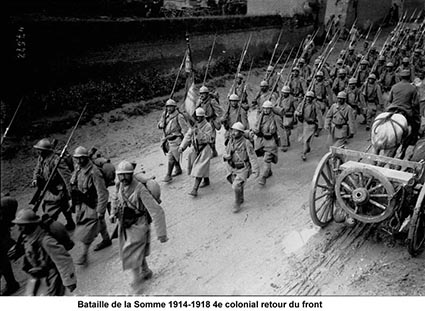
Credit photo website: Vaux-en-Amienois www.vaux-en-amienois.net
The United Kingdom:
Douglas Haig, General, the British commander on the Western Front. He had been part of the Doullens Conference on March 26th, 1918.
English soldiers mentioned this sticky mud, which coats equipment, clothes, and trenches. With each step and moment, this mud requires extra effort.
Artillery regiments:
Royal field artillery
Royal Engineers in Vignacourt.
108th Battery, 23rd Brigade 3rd Div. in the canton from 18th Jan to 10 Feb 1917. "The cook speaks French fairly well, he is from Jersey".
Cavalry units:
Essex Yeomanry - Picquigny, Havernas, Naours, HQ to Vignacourt - Dec 1917.
Flying Corps:
- Squadrons N°: 8, 20, 54, 80, 151 Royal Air Force - Vignacourt - 1918.
- 9 Squadron RAF operating from Flesselles on 4 July 1918.
- 29 squadron RAF stationed in Vignacourt, early June 1918.
- other units of RAF to Poulainville. (next to Bertangles, info regiment).
- 41 Squadron RAF - Fienvillers - Arrival 27 Mar 1918.
- 151 Squadron RAF - Vignacourt, 8 Sept to 24 Oct 1918.
- 201 Squadron RAF - Fienvillers, 28 March to 12 April 1918 and Poullainville &
Allonville (Surrounded on three sides by a wood) 6th to 14th August 1918.
- 19, 27, 70 Squadrons of 9th Wing Royal Flying Corps based in Fienvillers.
- other units of Royal Flying Corps RFC to Poulainville aerodrome. (Bertangles).
Infantry regiments:
British West Indies regiment - Amiens, Albert road 1916.
Durham Light Infantry - Vignacourt.
Cheshire Regiment:
15th Bn - Intensive training, Fienvillers, Flesselles 1917.
16th Bn - Railway work - Chaulnes, Nesle 1917.
Gloucestershire Regiment:
1/5th Battalion - near Flesselles - July 1915.
183rd Brigade - in the township - November 1916.
Gordon Highlanders:
- 1st, Entrained at Mericourt for Candas. 23th August to 6th October year TBC.
- 2nd - Ailly sur Somme, Vignacourt (train), Mericourt.
King's Liverpool regiments:
- 17th - billeting at Fremont, Vaux, nearest Vignacourt, side railroad.
- 18th - Vaux-en-Amienois. 1916 (March).
- 19th - billeting at Fremont, Vaux.
- 21st - billeted in the Vignacourt area. 1916 (September).
Lancashire Regiments:
1st Bn Loyal North Lancashire - Candas, Flesselles.
11th East Lancashire - moving throughout Longpré, Vignacourt.
Lucknow Brigade with Irish soldiers (infantry brigade British Army):
- Saint-Léger, located 4 mi from Vignacourt. Veterinary: M. Goodridge.
London Irish Rifles:
Units via Havernas and billeted in Flesselles - 21st to 23rd August 1916.
Manchester Regiment:
- 17th Bn - Domqueur and Vignacourt, at Bertangles - 1 night Nov 1915.
- 18th Bn - 29th Nov to 6th Dec 1915 - Training, wood cutting in Canaples,
From 17th Dec to 6th Jan 1916 in Canaples once more, Christmas time,
Battalion (3rd city) From 1st April to 1st May 1916, billeted to Picquigny.- 23rd Bn - Naours - 8th Feb to 16th Feb 1917.
- other units in Flesselles.
Northamptonshire Regiment:
- 1st Bn - Flesselles.
- 6th Bn - near Flesselles - July 1915 - Alfred Charles Dawes is buried in the British cemetery (August 1918).
Royal Irish Fusiliers:
- 11th Bn Royal Irish Rifle - Rubenpré, Mailly-Maillet, Fienvillers, and Saint-léger.... several days in November 1915.
Lieutnant Vance, Captain Samuel, Lieutnant Young, Lieutenant Ellis
in front of the guest house of Saint-Léger-lès-Domart (10 km - 6 mi from vignacourt)...
Courtesy of M. Michael Foight - Credit: "Digital Library@Villanova University"
Royal Scots Fusiliers:
- 1st Bn: Candas, Flesselles, Vaux-sur-Somme,
- 6th, 7th Bn: Prouville, Vignacourt.
- Division under the command of Captain SJ Platt - 1915.
Royal Sussex regiments:
- Bn in the vicinity.
Royal Warwicks:
- 14th Battalion - Vignacourt, Pont-Noyelles - End 1915 (3 days).
- 15th Battalion - Vignacourt, Coisy - End 1915 (a few days).
Sherwood Foresters (Notts & Derby Regt.)
- 1/8th Bn: Move by motor 'buses to Candas. Training and work for railway lines. From February 21 to March 5, 1916, the weather was cold with snowstorms. The crossing of Doullens on March 6, 1916, was a day of snow.
- 15th Bn: Plain of Santerre, February 1917; 7th February, Candas; 8th February, St. Vaast en Chaussée (billeting and training) until the 18th for a march to Flesselles for a train to Marcelcave.
South Staffordshire:
- 1st Bn: Vaux-en-Amienois, Entrained at Vignacourt for Méricourt.
- 2nd Bn: Entrained at Mericourt-l'Abbé for Saleux, Belloy, Vignacourt, and Fienvillers.
Ulster division:
- 36th Ulster division with Irish soldiers (infantry brigade in the British Army): From October 5 to 9, 1915, Flesseles, Domart, and Canaples worked on the railway, cutting trees, digging trenches, and Thiepval, with the Thiepval Ulster Tower dedicated to Northern Ireland soldiers. (Suckling pigs were bought from farmers for Christmas.) December 1915 to January 1916.
- North Irish Horse, 1919.
Yorkshire Regiment:
- 1st Bn - West Yorkshire regiment - Vignacourt End August 1916.
- 2nd Bn - West Yorkshire regiment - Saint-Vaast - March 1915.
- 6th Bn - West Yorkshire regiment - Steel helmets distributed, training near the forest, and some soldiers helping to lay new railway junctions - Vignacourt 1915.
- 23rd Bn - West Yorkshire regiment - Bourdon - March 1915.
- 25th Bn - West Yorkshire regiment - Flesselles - March 1915.
- 70th Bn - West Yorkshire regiment - Vignacourt - March 1915.
- Units of the West Yorkshire regiment in Naours, Havernas, St-Ouen, and Pernois valley (training and maneuver exercises sometimes causing damage to crops).
- Bn East Yorkshire Regiment - Vignacourt.
Worcestershire:
- 1st: Longueau, march through Amiens, and billeted in St-Sauveur.
- 4th: march from Vignacourt to Beauval and march to Doullens.
- 11th: Billeting and training in Vaux-en-Amienois from October 22 to November 1, 1915.
- other units billeted in Saint-Riquier, Flesselles, and Villers-Bocage.
The United States:
Infantry battalions:
- 28th Infantry Regiment United States - Cantigny - 1918 and other units.
- Saint-Quentin - Aisne
- The 131st U. S. infantry (1st Infantry Illinois National Guard) - 1918
(Capt. James D. Melville, commanding.)
Flying Corps:
- 17th American Aero Squadron - Fienvillers, Bertangles March 1918 -
Auxi-le-Château, a few days in August 1918.
- 148th American Aero Squadron - Remaisnil - Sept 1918.
Several nationalities:
Chinese Labour Corps - Vignacourt and Vaux-en-Amienois, Fremont. They worked on the railroad and dug trenches.
Indian Labour Corps - Vignacourt - Kkongji PYRTON Indian Labour corps - 34th Khasi coy, is buried in the military cemetery.
Indian soldiers (Maybe 9th Hodson's Horse) - camp near Querrieu 15 mi from Vignacourt - July 1916.
Moroccan Rifle regiment - Vignacourt.
Senegalese riflemen
Senegal, Sudan - They doubled Amiens Canaples rails with territorial regiments. 1915 - 1916.

